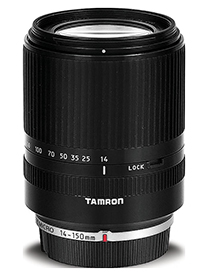 Tamron has been a pioneer in manufacturing compact zoom lenses with very high zoom ratios (popularly known as the super zooms). Following this tradition, Tamron has introduced this lens which has a zoom ratio of 10.7. It belongs to the Di III Series which are specifically meant for the CSCs (Compact System Cameras or mirrorless cameras). This is the first offering by the company for the popular MFT (Micro 4/3) format. As you may recall, MFT is an open standard and compatible cameras are made by Olympus, Panasonic and Kodak. MFT format has a crop factor of two.
Tamron has been a pioneer in manufacturing compact zoom lenses with very high zoom ratios (popularly known as the super zooms). Following this tradition, Tamron has introduced this lens which has a zoom ratio of 10.7. It belongs to the Di III Series which are specifically meant for the CSCs (Compact System Cameras or mirrorless cameras). This is the first offering by the company for the popular MFT (Micro 4/3) format. As you may recall, MFT is an open standard and compatible cameras are made by Olympus, Panasonic and Kodak. MFT format has a crop factor of two.
Design & Build Quality
The Tamron 14-150mm f/3.5-5.8 Di III is a twist-type zoom lens, with a metal body and a rubberized grip for the zoom and manual focus rings. This gives the lens a very smart look which is accentuated by a chrome ring near the mount. The build quality is solid, without any wobbling even when the lens is extended. The lens mount is made from metal. The lens tips the scales at a moderate 288 grams and is very compact. The filter thread size is the standard 52 mm diameter.
Key Features
The Tamron 14-150mm f/3.5- 5.8 Di III is a variable aperture zoom designed for the Micro Four Thirds System, with apertures varying from f/3.5 at 14mm to f/5.8 at 140mm. This focal length is equivalent to 28-300mm in the 35mm system. Focal lengths are marked clearly in white at 14, 25, 35, 50, 70, 100 and 150mm settings. The broad zoom ring is towards the front of the lens and as mentioned earlier, has a very nice, serrated rubber grip. The manual focus ring is also rubberized but is quite narrow. Distance and depth of field scales are absent. There is just one switch on the lens – a lock – to prevent zoom creep. As with most modern lenses there is no aperture ring, the aperture being controlled from the camera body.
As with lenses with this high a zoom ratio, the Tamron 14- 150mm lens has a complex design, with 17 elements in 13 groups. The lens uses two molded-glass aspherical elements and one hybrid aspherical element to minimize aberrations. There is also one LD (low dispersion) glass element to increase image sharpness and colour fidelity. The diaphragm is seven bladed for a good bokeh. Autofocus is driven by a stepping motor for fast and quiet AF performance as needed for video recordings. The only major feature that is missing is the image stabilization (IS). This, we were told was a design decision to keep the lens ultra-compact. Lack of IS may not cause any problems with Olympus cameras (and the Panasonic GX7) which have IBIS (In Built Stabilization System), but could be a deal-breaker for other cameras that don’t have this feature. The lens uses an internal focusing design and hence its overall length does not change while focusing. It does extend quote a bit when zooming though. The front element does not rotate, making it convenient to use C-PL and ND filters.

